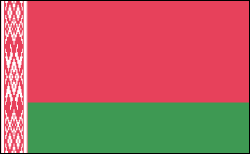BELARUS

Geography: Much of Belarus (formerly the Belorussian Soviet Socialist Republic of the USSR, and then Byelorussia) is a hilly lowland with forests, swamps, and numerous rivers and lakes. There are wide rivers emptying into the Baltic and Black seas. Its forests cover over one-third of the land and its peat marshes are a valuable natural resource. The largest lake is Narach, 31 sq mi (79.6 sq km).
Government: Republic.
History: In the 5th century A.D. , Belarus (also known as White Russia) was colonized by east Slavic tribes. Kiev dominated it from the 9th to 12th century. After the destruction of Kiev by the Mongols in the 13th century, the territory was conquered by the dukes of Lithuania, although it retained a degree of autonomy. Belarus became part of the Grand Duchy of Lithuania, which merged with Poland in 1569. Following the partitions of Poland in 1772, 1793, and 1795, in which Poland was divided among Russia, Prussia, and Austria, Belarus became part of the Russian empire.
Following World War I, Belarus proclaimed itself a republic, only to find itself occupied by the Red Army soon after its March 1918 announcement. The Polish-Soviet War of 1918–1921 was fought to decide the fate of Belarus. West Belarus was ceded to Poland; the larger eastern part formed the Belorussian SSR, and was then joined to the USSR in 1922. In 1939, the Soviet Union took back West Belarus from Poland under the secret protocol of the Nazi-Soviet Nonaggression Pact and incorporated it into the Belorussian Soviet Socialist Republic. Occupied by the Nazis in World War II, Belarus was one of the war's most devastated battlefields.
When the Chernobyl nuclear power plant in Ukraine exploded in 1986, 70% of its radioactive fallout fell on the Belorussian SSR. Cancer and other illnesses have multiplied as a result.
History: In the 5th century A.D. , Belarus (also known as White Russia) was colonized by east Slavic tribes. Kiev dominated it from the 9th to 12th century. After the destruction of Kiev by the Mongols in the 13th century, the territory was conquered by the dukes of Lithuania, although it retained a degree of autonomy. Belarus became part of the Grand Duchy of Lithuania, which merged with Poland in 1569. Following the partitions of Poland in 1772, 1793, and 1795, in which Poland was divided among Russia, Prussia, and Austria, Belarus became part of the Russian empire.
Following World War I, Belarus proclaimed itself a republic, only to find itself occupied by the Red Army soon after its March 1918 announcement. The Polish-Soviet War of 1918–1921 was fought to decide the fate of Belarus. West Belarus was ceded to Poland; the larger eastern part formed the Belorussian SSR, and was then joined to the USSR in 1922. In 1939, the Soviet Union took back West Belarus from Poland under the secret protocol of the Nazi-Soviet Nonaggression Pact and incorporated it into the Belorussian Soviet Socialist Republic. Occupied by the Nazis in World War II, Belarus was one of the war's most devastated battlefields.
When the Chernobyl nuclear power plant in Ukraine exploded in 1986, 70% of its radioactive fallout fell on the Belorussian SSR. Cancer and other illnesses have multiplied as a result.

Map of Belarus
President: Alyaksandr Lukashenka
(since 1994)
Prime Minister: Andrey Kabyakow
(since 2014)
Total area: 80,154 sq mi (207,600 sq km)
Population (2014 est.): 9,608,058
(growth rate: -0.19%); birth rate: 10.86/1000; infant mortality
rate: 3.64/1000; life expectancy: 72.15
Capital and largest city (2011 est.):
Mensk (Minsk), 1.861 million
Other large cities: Gomel, 502,200;
Mogilyov, 374,000; Vitebsk, 355,800; Grodno, 314,100; Brest,
306,300; Bobruysk, 228,100
Monetary unit: Belorussian ruble
National Name: Respublika
Byelarus'
Languages:
Belarusian (official) 23.4%, Russian (official) 70.2%, other
3.1% (includes small Polish- and Ukrainian-speaking minorities),
unspecified 3.3% (2009 est.)
Ethnicity/race:
Belarusian 83.7%, Russian 8.3%, Polish 3.1%, Ukrainian 1.7%, other 2.4%, unspecified 0.9% (2009 est.)
Religion:
Eastern Orthodox 80%, other (including Roman Catholic, Protestant, Jewish, and Muslim) 20% (1997 est.)
National Holiday:
Independence Day, July 3
Literacy rate: 99.6% (2009 est.)
Economic summary: GDP/PPP (2013
est.): $69.24 billion; per capita $16,100. Real growth rate:
2.1%. Inflation: 19%. Unemployment: 1% (2009 est.)
officially registered unemployed; large number of underemployed
workers. Arable land: 26.63%. Agriculture: grain,
potatoes, vegetables, sugar beets, flax; beef, milk. Labor force:
5 million (2009); agriculture 9.4%, industry 45.9%,
services 44.7% (2003 est.). Industries: metal-cutting machine
tools, tractors, trucks, earthmovers, motorcycles, televisions,
chemical fibers, fertilizer, textiles, radios, refrigerators.
Natural resources: forests, peat deposits, small quantities
of oil and natural gas, granite, dolomitic limestone, marl, chalk,
sand, gravel, clay. Exports: $45.17 billion (2013
est.): machinery and equipment, mineral products, chemicals, metals,
textiles, foodstuffs. Imports: $45.17 billion (2012
est.): mineral products, machinery and equipment, chemicals,
foodstuffs, metals. Major trading partners: Russia,
Netherlands, Germany, Ukraine, China, Latvia (2012).
Communications: Telephones: main lines
in use: 4.407 million (2012); mobile cellular: 10.675 (2012).
Broadcast media: 4 state-controlled national
TV channels; Polish and Russian TV broadcasts are available in some
areas; state-run Belarusian Radio operates 3 national networks and an
external service; Russian and Polish radio broadcasts are available
(2007).
Internet hosts: 295,217 (2012). Internet users: 2.643
million (2009).
Transportation: Railways: total: 5,537
km (2008). Highways: total: 86,392 km (2010). Waterways:
2,500 km (major rivers are the west-flowing Western Dvina and Neman
rivers and the south-flowing Dnepr River and its tributaries, the
Berezina, Sozh, and Pripyat rivers) (2011).
Ports and harbors: Mazyr. Airports: 65 (2013).
Transportation: Railways: total: 5,512
km (2004). Highways: total: 79,990 km; paved: 69,351 km;
unpaved: 10,639 km (2004). Waterways: 2,500 km (use limited
by location on perimeter of country and by shallowness) (2003).
Ports and harbors: Mazyr. Airports: 101 (2005).
International disputes: boundary
demarcated with Latvia and Lithuania; as a member state that forms part
of the EU's external border, Poland has implemented strict Schengen
border rules to restrict illegal immigration and trade along its border
with Belarus.
-------------------- o --------------------
No comments:
Post a Comment